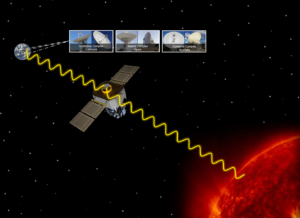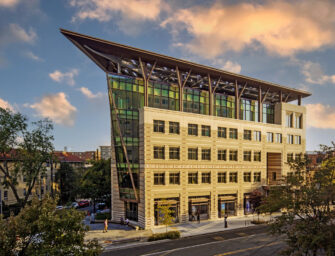22 Years of Solar and Heliospheric Observatory
By Bernhard Fleck (ESA SOHO Project Scientist, NASA/GSFC), Joseph Gurman (NASA SOHO Project Scientist, NASA/GSFC), David Sibeck (Past President, AGU Space Physics and Aeronomy Section, NASA/GSFC)

The Solar and Heliospheric Observatory (SOHO) studies the internal structure of the Sun, its outer atmosphere and solar winds, and the stream of ionized gas that is constantly blowing outward through the Solar System. It is a joint cooperative effort between the European Space Agency (ESA) and NASA. Image by NASA
The 2nd of December 2017 marks the 22nd launch anniversary of the European Space Agency (ESA) – NASA Solar and Heliospheric Observatory (SOHO). SOHO is the longest-lived heliophysics mission still operating and has provided a nearly continuous record of solar and heliospheric phenomena over a full 22-year magnetic cycle (two 11-year sunspot cycles). SOHO’s findings have been documented in over 5000 papers in the peer reviewed literature, authored by more than 4,000 scientists worldwide. SOHO provided the first ever images of structures and flows below the Sun’s surface and of activity on the far side of the Sun. SOHO discovered sunquakes and eliminated uncertainties in the internal structure of the Sun as a possible explanation for the “neutrino problem” which concerned the large discrepancy between the high flux of solar neutrinos – particles which are now believed to possess mass and travel at almost the speed of light – predicted from the Sun’s luminosity and the much lower flux that is observed. The ultraviolet imagers and spectrometers on SOHO have revealed an extremely dynamic solar atmosphere where plasma flows play an important role and discovered dynamic solar phenomena such as coronal waves. SOHO measured the acceleration profiles of both the slow and fast solar wind and identified the source regions of the fast solar wind. SOHO revolutionized our understanding of solar-terrestrial relations and dramatically boosted space weather forecasting capabilities by providing, in a near-continuous stream, a comprehensive suite of images covering the dynamic atmosphere and extended corona. SOHO has measured and characterized over 28,000 coronal mass ejections (CMEs). CMEs are the most energetic eruptions on the Sun and the major driver of space weather. They are responsible for all of the largest solar energetic particle events in the heliosphere and are the primary cause of major geomagnetic storms. SOHO’s visible-light CME measurements are considered a critical part of the US National Space Weather Action Plan. For two solar activity cycles SOHO has measured the total solar irradiance (the “solar constant”) as well as variations in the extreme ultraviolet flux, both of which are important to understand the impact of solar variability on Earth’s climate. Besides watching the Sun, SOHO has become the most prolific discoverer of comets in astronomical history: as of late 2017, more than 3,400 comets have been found by SOHO, most of them by amateurs accessing SOHO real-time data via the Internet.
In such complex areas of research as solar physics, progress is not limited to the work of a few people working by themselves. The scientific achievements of the SOHO mission result from a concerted, multi-disciplinary effort by a large, international community of solar scientists, including sound investments in space hardware, coupled with vigorous and well-coordinated scientific operations and interpretation efforts. Also, it is important to note that SOHO was not conceived as a “stand-alone” mission. Together with Cluster – a set of four identical spacecraft operated as a single experiment to explore in three dimensions the plasma and small-scale structure in the Earth’s plasma environment – SOHO formed the Solar-Terrestrial Science Programme (STSP), the first cornerstone of the European Space Agency’s long-term program called “Space Science Horizon 2000”, which was implemented in collaboration with NASA. STSP itself was part of an even larger international effort by NASA, ESA, and JAXA: The International Solar-Terrestrial Physics (ISTP) program, which included SOHO, Cluster, Geotail, Wind, and Polar, achieved an unprecedented understanding of the physics of solar-terrestrial relations by coordinated, simultaneous investigations of the Sun-Earth space environment over an extended period of time and, thus, can be considered the predecessor of NASA’s Living With a Star (LWS) program.
While SOHO’s continued operation into the 2020s depends only on the longevity of its solar arrays, there is as yet no defined mission to succeed it in providing continuous, earth-Sun-line coronagraph observations. Prior to SOHO, our maximum warning time for extreme, earth-directed solar storms was measured in minutes; now it is 1 – 2 days. It would be prudent to preserve that advantage.



There are no comments
Add yours